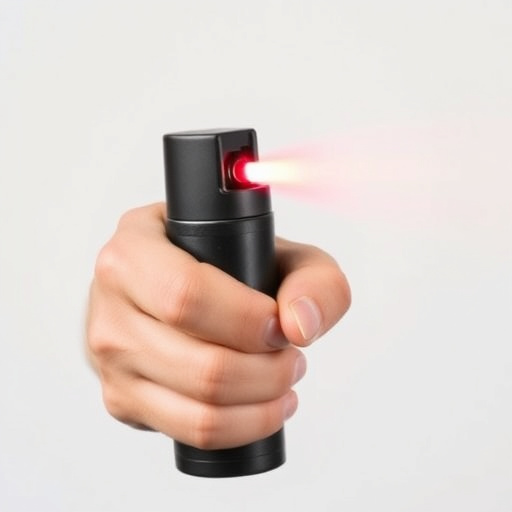Pepper spray, with its capsaicin active ingredient from chili peppers, effectively deters and temporarily disorients aggressive dogs, allowing individuals time to escape or seek help. When choosing a device, consider stronger formulations, range, ease of use, and local legalities, as regulations vary by region. Safe storage, understanding canine behavior, and practical training scenarios are crucial for responsible and effective pepper spray defense against dogs.
“Uncover the power of self-defense with a strategic weapon for dog encounters—pepper spray. This comprehensive guide explores its effectiveness against dogs, empowering owners to make informed choices. Learn how to select the ideal self-defense inflammatory spray device, navigate legal boundaries, and master safety guidelines. From understanding the science behind pepper spray’s action to training techniques for optimal use, this article ensures you’re prepared for unexpected situations. Arm yourself with knowledge and protect yourself and your loved ones.”
- Understanding Pepper Spray and Its Efficacy Against Dogs
- How to Choose the Right Self-Defense Inflammatory Spray Device
- Legal Considerations and Safety Guidelines
- Training and Effective Use Techniques
Understanding Pepper Spray and Its Efficacy Against Dogs
Pepper spray, a popular self-defense tool, has shown significant effectiveness against dogs. When faced with an aggressive canine, a quick burst of pepper spray can deter and disable the animal temporarily. The active ingredient in pepper spray, capsaicin, is derived from chili peppers and irritates the dog’s eyes, nose, and throat, leading to discomfort and disorientation. This inflammatory spray device offers a non-lethal option for individuals encountering potentially dangerous dogs, providing them with time to escape or call for help.
In terms of Pepper Spray Defense Against Dogs, studies indicate that well-aimed applications can successfully disrupt an attack. The spray creates a visual barrier and causes the dog to experience a burning sensation, making it more likely to retreat. However, it’s important to note that factors like the dog’s size, breed, and training can influence its reaction. Users should be aware of local regulations regarding pepper spray possession and usage around animals to ensure responsible and safe handling.
How to Choose the Right Self-Defense Inflammatory Spray Device
When selecting a self-defense inflammatory spray device, understanding your specific needs is key. Consider the primary threats you’ll be facing—whether it’s a potential attack from an individual or protection against aggressive dogs. For dog defense, opt for pepper spray designed specifically to deter canine aggression; these formulas are often stronger and formulated to cause temporary blindness and irritation in dogs, enabling you to escape safely.
Features like range, effectiveness, ease of use, and carry options are crucial. Look for a device with a good reach to keep potential attackers at bay, ensuring it delivers a powerful enough spray to incapacitate. Additionally, consider the device’s activation mechanism—some require a trigger pull, while others use motion-activated or pressure-sensitive nozzles. Choose one that feels comfortable in your hand and is easily accessible, allowing for quick deployment when needed.
Legal Considerations and Safety Guidelines
When considering a pepper spray device for self-defense against dogs, it’s crucial to understand the legal considerations in your region. Pepper spray is often legal for personal protection, but regulations vary greatly by state and country. Always check local laws to ensure compliance; possession or use of such devices may be prohibited or come with restrictions in certain areas.
Safety guidelines are paramount when handling any self-defense tool. Store pepper spray out of reach of children and pets, and keep it in a secure, easily accessible location. Familiarize yourself with the device’s operation before needing to use it; practice aiming and deploying the spray safely. Understand that pepper spray is designed to incapacitate temporarily, not to cause permanent harm. Responsible use respects the principle of self-defense while adhering to ethical and legal boundaries.
Training and Effective Use Techniques
Training is crucial for effectively using a pepper spray device, especially when facing aggressive dogs. It’s essential to learn proper application techniques, including aiming, pumping, and delivering the spray accurately. Practice scenarios involving simulated dog interactions can help users build confidence and refine their skills in handling potentially dangerous situations.
Understanding how to use pepper spray against dogs involves knowing their behavior patterns during attacks. Training sessions should cover identifying warning signs, such as growling or snarling, and teach users to respond swiftly with a strategic spray application. This defensive measure can help deter and temporarily incapacitate the dog, providing valuable time for escape or assistance.
When it comes to protecting yourself against aggressive dogs, a self-defense inflammatory spray device can be a powerful tool. Understanding the efficacy of pepper spray against canines and mastering the correct usage techniques are paramount. With the right device and knowledge of legal boundaries, individuals can effectively deter potential dog attacks, enhancing their safety in various situations. Remember, proper training and adherence to safety guidelines are key to ensuring this method remains a reliable Pepper Spray Defense Against Dogs strategy.
